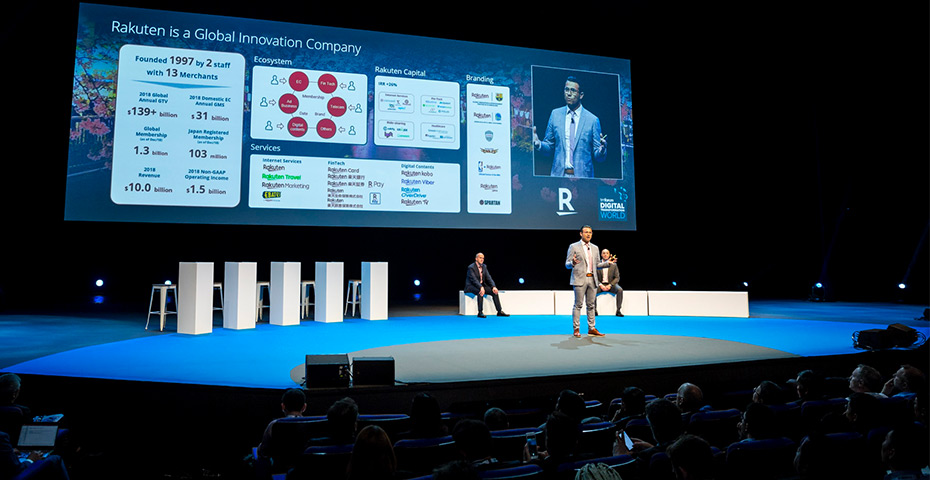Rakuten, a global e-commerce giant based in Japan, has announced plans to roll out its own mobile network. Its approach to mobile- and digital-first customer experience is making waves across the global telecom industry and provides a powerful example of the competition and expectations all mobile operators face as the digital era rolls on. Rakuten’s vision for in-store experiences, digital identity, customer rewards and the mobile lifestyle will be powered in part by solutions from Netcracker Technology. Here we explain Netcracker’s role in enabling Rakuten’s vision, the example it sets for digital-first experiences, and the economic benefits mobile operators can achieve by employing similar approaches.
Who is Rakuten and what differentiates it from other e-commerce providers?
Rakuten offers more than e-commerce. It provides a massive services ecosystem across loans, credit cards, travel, insurance and consumer goods. Customers are considered members of this ecosystem and are offered a lifestyle experience that isn’t matched by the major e-commerce giants like Amazon and eBay.
Rakuten operates in over thirty countries and is actively expanding. At MWC19, Rakuten announced that it is rolling out the world’s first cloud-native mobile network, marking the first time that a non-telco has deployed its own facilities-based mobile network. NEC and Netcracker have each been named as key suppliers to this initiative. In particular, NEC is collaborating with Rakuten to deliver vRAN technology that is key to Rakuten’s goal of a fully cloud-native, virtualized, 5G-ready network that is being deployed and will operate at a substantially lower cost than traditional mobile networks. Netcracker’s role is focused in the customer and revenue management domains, where Netcracker’s next-gen customer and revenue management solutions will help to bring Rakuten’s digital- and mobile-first vision for customer experience and membership rewards to life.
What sets apart Rakuten’s cloud-native mobile network? How does it function?
Rakuten has announced that it will use an entirely virtualized radio access network (vRAN) coupled with a distributed, common carrier-grade telco cloud. All of the services and capabilities of the network are cloud-native and software-based. It will utilize, from the start, a 5G-ready, IPv6-based transport network for backhaul with a completely software-defined programmable infrastructure.
The network will also combine mobile-edge computing with SDN-enabled centralized and regional data centers. This is a sophisticated way of saying that it's really architected optimally for software-based and application-based services that can be instantiated and controlled on-demand, as you'd expect to see in any cloud-native environment. This is a real digital-first approach from the ground up.
It will also utilize a zero-touch, end-to-end automation and assurance layer for service delivery, based on unified OSS and BSS. This is very different from traditional OSS/BSS which does not typically automate or integrate all of these functions end-to-end. Everything is software controlled and built to very particular specifications. It will enable a much higher degree of 'on-demand' centralized control with greater end-to-end automation for service activation, delivery and control than has been achieved in any traditional mobile network. It is also a much lower cost infrastructure. In short, Rakuten’s approach is faster, easier to manage, much more automated and costs less to operate, deploy and upgrade. Additionally, Rakuten’s architecture is designed to make upgrading to 5G seamless. It is a digital-era way of looking at how a mobile network can perform and act as a service platform.
Though Rakuten’s mobile network will start in Japan, the company has stated that its vision is ultimately global. Given that most digital businesses take a global approach because the Internet is a global network, it makes sense that Rakuten would see things similarly. It will be fascinating to watch this company tackle the challenge of taking mobile, which has always been based on a national or regional model, and turning into a global offering. That might even be the most entrepreneurial and disruptive aspect of what Rakuten can do.
Why did Rakuten choose Netcracker has a key supplier and strategic partner?
Netcracker is the worldwide leader in BSS, OSS and SDN/NFV solutions for CSPs as well as for a range of digital businesses outside of telecom. Rakuten has chosen Netcracker to power its customer experience vision and to provide a unique approach to revenue management.
Netcracker was selected as a key strategic partner in part because we offer an unmatched solutions delivery track record, a very strong technology platform, the right solutions for the particular challenges at hand and an ability to provide those solutions rapidly and on a global basis. In particular, Rakuten Mobile CTO Tareq Amin cited our “shared DNA” for creating innovative solutions to classic problems telecoms and other complex businesses face, particularly in the face of the digital era’s impact on most industries.
How is Netcracker helping Rakuten take a different approach to traditional mobile operators?
One good example people can relate to is how Rakuten will redefine how things work in the mobile shop. Billions of people are mobility customers and many can tell stories about negative in-store experiences with operators: waiting in the queue; staring at the back of a screen while a staff member types; struggling to make sense of signage and different offers; confusing and seemingly convoluted processes for doing things as simple as upgrading a device or changing a plan. Rakuten wants to do all of this differently and bring a self-serve, mobile-first experience right into the store. The goal of that, for example, would be to reduce a 2 hour customer sign-up process down to 5 minutes, which has clear benefits in terms of the cost to add subscribers, better use of time in the shop to do things such as, say, shop and for the overall customer experience, particularly at the outset of a customer relationship.
Netcracker is providing the foundation for all of this with its customer experience solution, helping to automate the entire shopping, ordering and fulfilment process with a digital- and mobile-first, omni-channel approach from the start. While all of this is important to making customers happy, there’s also a major cost advantage to delivering this degree of automation, commonality across processes and time to execution of orders or purchases. It pushes many of the traditional costs associated with manual processes and with fixing associated problems right out of the business. It’s also a much more streamlined IT architecture that doesn’t carry forward most of the cost associated with disparate, legacy IT estates.
Because Rakuten views customers as members within its ecosystem, how does this change its approach to revenue management and what is Netcracker doing to bring Rakuten’s mobile services into this model?
In telecom, revenue management is often thought of as billing, rating and charging for events or services that are consumed like minutes, messages or data units. This is true for Rakuten, but it’s secondary to a greater concept of value transfer in its ecosystem.
Members are rewarded with a unique points system for everything they do. These points are redeemable for goods and services. So, for example, a mobile bill could be paid with points that are earned by using a credit card or buying travel insurance or home goods through Rakuten. Similarly, using mobile services through Rakuten will generate points that can be used across any other service in the ecosystem.
Points aren’t just for purchasing; they have status associated with them. As a result, as members gain points, they become eligible for new things, like a premier credit card with added benefits, free shipping on hard goods, or upgrades on new mobile devices.
Netcracker will be the engine in the background that translates mobile usage into tangible value in this ecosystem, managing the complex eligibility rules that govern the added benefits members earn and access while also communicating that information through management of the end to end customer journey. It’s an exciting role to play, because Netcracker can show what’s possible in a pure digital setting with a much broader range of services and entitlements.
As service providers in general try to simplify things for their customers and automate more of the rewards and benefits customers can earn, this model can provide a very powerful example of what the possibilities are in a mobile environment that’s become much more about lifestyle than just minutes or data units. That is likely where more operators need to end up, because the path to growth is more about adding value and connecting customers digitally to more of the things they need in everyday life.
The benefit of this approach to value transfer is that it gives customers a greater sense of working toward something of value every time they use their mobile device. Given how often people use their mobile devices, this is a logical and powerful idea. Being the technology partner who gets to make that value come to life is a great role for Netcracker.


